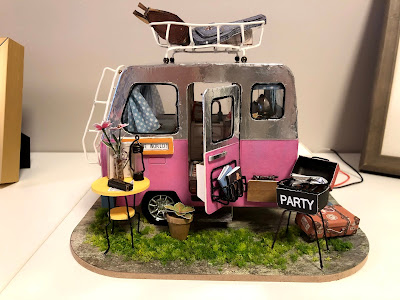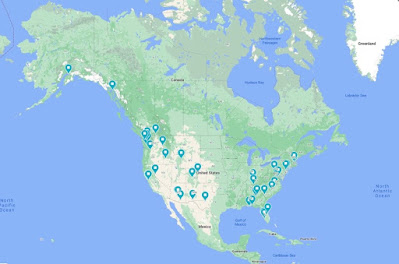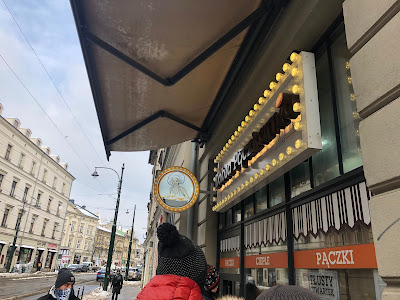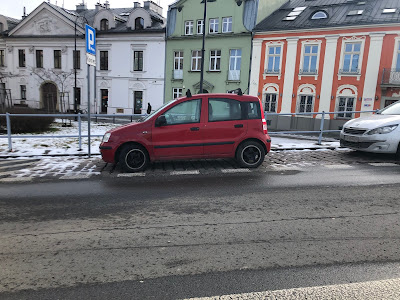Saturday, February 27, 2021
Covid Update 2021
Sunday, February 21, 2021
Van Plan Update
For the past two months I have been dedicating a significant amount of time each week to figuring out where Cameron and I should live post-Poland. It's not as easy as simply saying "oh, I liked Missoula the time I was there for work and I always thought I would like Maine," although that is a part of it. I am quite meticulous about the process and I want to find the best option, and I do believe perfect can exist.
Now that I have narrowed our list of potential towns to live in to less than 50, I'm ready to share the first stages of the van plan process.
Step 1: What are our options?
I didn't want to neglect an opportunity, just because I hadn't heard of it before, so in addition to the list of towns and cities I already knew I was interested in, I asked for the recommendations of friends and family, took personality quizzes that resulted in the top places to live, and the "best places to live for ____" from various sources. I could have stopped there, but then I also researched the best places to visit and live state-by-state and and the top 50 towns and cities in the US and Canada. At this point I had an overwhelming 600+ cities, towns, and villages on the list. The next several steps were to narrow this massive number to less than 50.
Step 2: Livability Scores
For some of the places, I was jotting down notes on what to see while there or why it was an ideal spot, but for the most part I was still flying blind. I needed a way to make a massive cut, so I found a website that gave an overall livability scores and A-F rankings across various categories. For each place I marked down the livability score, any categories that the town scored an A in, and any categories that it scored a D or F in. Anything that scored less than 70 was nixed (bringing us to 371 places) and any towns with a D or F schools rating (brining us down to 302).
A cut of 50% is great, but 300 is still a huge number to work with. That 302 number could have been a little smaller but there are a few places that I kept on the list even when they didn't meet the standards everywhere else was held to. This was true throughout the process, so places like Bellingham, WA and Hood River, OR made it onto the final list even though they weren't perfect. Some of those originally saved places (like Juneau and Anchorage, AK) did ultimately get cut in further rounds of review.
Step 3: Population Density, Median Age, Male/Female Ratio
I found another website that gave each municipality's population, population density, median age, and male-to-female ratio, among other statistics that I didn't care about. It's not like I started this project thinking "I need a town that has a perfect 1:1 male:female ratio," but I figured if the information was easily available I may as well track it. I ended up removing anyplace with a ratio greater than 1.5:1 or less than 0.5:1, as well as towns with a median age greater than 50.
I figured that population density was more telling of how comfortable it would be for me to live somewhere than pure population count, but after compiling all of the data I realized I wasn't really sure what my ideal population density range was. I didn't end up cutting any places based on either population statistics, but the current top locations range from populations of 1,371,193 down to 1,282 and densities of 5,828 to 87 people per square mile. Surprisingly, the second largest city by population (Ottawa Ontario with a a population over 1 million) is the second least most densely populated (only 365 people per square mile).
Step 4: What airport options are available?
Figuring this out was a little tricky because just looking up "airports close to _____" ends up bringing up teeny tiny regional airports that only fly to 4 other teeny tiny towns in the surrounding counties. I ended up having to compile information from Google Maps and a flight booking service. Any place that was further than 60 miles from from an airport that could fly to El Paso, TX (with one layover or less) got nixed. This brought us down to 256 towns.
Step 5: Other City Demographics
At this point, 256 felt like way too much to still be dealing with and I was ready to start being a little more cut-throat about getting rid of spots on this list. Next I went through another series of categorical ratings with a little less willingness to keep ones who were missing the mark on the list. The next round of cuts were for towns that scored less than a B- on their crime rate or diversity scores, places with less than 20% of the population having a bachelors degree, a diversity rate greater than 20%, and median house costs greater than $700,000.
Step 6: Skiing Options
At this point, I was still sitting on over 100 towns, and the more towns there are the longer it takes to research the next criteria. These 136 remaining places were still very spread across the US with a surprising number in Illinois and Ohio. I was getting sick of seeing so many midwest and southern towns dominating the list so it was time to bring in the ringer- proximity to good skiing.
This, too, took layers of research involving Google Maps, looking up "best skiing near _______," ski area maps, and other resort-specific Googling. I ended up cutting towns that were over 100 miles away from a ski area, and that nearby ski area had to have a vertical drop of at least 500 feet and a ski summit greater than 1000 feet. I laughed when I saw the only option for Texans was to drive 600+ miles to Ski Apache, the small ski area in Ruidoso that I used to be an instructor at. No surprise, the big south eastern portion of the US got removed and our total town count dropped down to 74.
Step 7: Walking Scores
50 was the magic number, but still even this next round didn't quite get us there. I've gotten quite used to being able to walk to work and run all of my errands by foot, so tracking the walking scores was next. Once again, I relied on a website. Even though I was eager to get below 50, I still made some exceptions to the rule I set (towns must have a walking score of 30 or higher) so I was left with 62 remaining municipalities.
Step 8: Final Cuts
I wasn't sure what else I could do with this list of 62. Even though I was able to find the average temperature highs and lows, finding a consistent way to track average humidity highs was impossible. Although high humidity is a big no no for me, it will have to be something we figure out as we go.
Another qualifier I was thinking of was distance to usable water (lake, ocean, river, etc.), but after the hassle of figuring out skiing, it didn't seem worth the work. At this point, I had seen each of these places on a map several times and knew that each of them were surrounded by blue splotches, so anyways I figured even if I did put in the work, it wouldn't result in any further cuts.
Other considerations were for common natural disasters, local shopping options, annual town activities, quality of public transportation, variety of restaurants, quality of healthcare... just too many, and none that I cared that much about. Eventually, it was a simple as Cameron saying "I don't want to live in French-speaking Quebec," so the 20-ish towns within the province of Quebec were removed, bringing us down to 43. It was quite a relief, and I will add the list to the bottom of this post.
So what's next?
This list of potential places to live was just one of three. I also have lists for places we want so see for social reasons and for personal activity interests. I'm in the process of mapping those all out to see what makes sense to see along the way to seeing these 43 spots. In addition to developing a loose route and timeline, I also want to research where we can park the van, where we can use the toilet, our shower options, our clothes washing options, public internet hot-spots, etc.
Cameron is starting to dig into our van options a bit more and researching what interior set up options might be best. Today, he started to inform me that for the low low price of $600 we could have a collapsable hot tub that only takes three hours to heat up! This is after he told me he wants to consider buying a brand new custom designed four wheel drive Sprinter cargo van rather than buying a used one *major eye roll*. We won't really have to make that decision until we move to the US and are actually able to make the purchase, but until then my goal is to plan everything that can be planned ahead of time.
| Region | State | City |
| Central Canada | Ontario | Carleton Place |
| Central Canada | Ontario | Ottawa |
| Central Canada | Ontario | Russell |
| East North Central | Michigan (MI) | Berkley |
| East North Central | Michigan (MI) | Grosse Pointe Park |
| East North Central | Michigan (MI) | Grosse Pointe Woods |
| East North Central | Michigan (MI) | Rochester |
| East North Central | Wisconsin (WI) | De Pere |
| Middle Atlantic | New York (NY) | Cazenovia |
| Mountain West | Arizona (AZ) | Flagstaff |
| Mountain West | Colorado (CO) | Crested Butte |
| Mountain West | Colorado (CO) | Littleton |
| Mountain West | Colorado (CO) | Louisville |
| Mountain West | Colorado (CO) | Steamboat Springs |
| Mountain West | Idaho (ID) | Boise |
| Mountain West | Idaho (ID) | Coeur d'Alene |
| Mountain West | Idaho (ID) | Meridian |
| Mountain West | Montana (MT) | Missoula |
| Mountain West | Montana (MT) | Whitefish |
| Mountain West | New Mexico (NM) | Los Alamos |
| Mountain West | Utah (UT) | Mountain Green |
| Mountain West | Utah (UT) | South Jordan |
| Mountain West | Wyoming (WY) | Buffalo |
| Mountain West | Wyoming (WY) | Jackson |
| New England | Massachusetts (MA) | Milton |
| New England | Massachusetts (MA) | Sharon |
| New England | Massachusetts (MA) | Waltham |
| New England | Vermont (VT) | Montpelier |
| Pacific West | Oregon (OR) | Bend |
| Pacific West | Oregon (OR) | Corvallis |
| Pacific West | Oregon (OR) | Hood River |
| Pacific West | Oregon (OR) | Sherwood |
| Pacific West | Oregon (OR) | Sisters |
| Pacific West | Washington (WA) | Bellingham |
| Pacific West | Washington (WA) | Gig Harbor |
| Pacific West | Washington (WA) | Kirkland |
| Pacific West | Washington (WA) | Leavenworth |
| Pacific West | Washington (WA) | Olympia |
| Pacific West | Washington (WA) | Port Angeles |
| Prairie Canada | Alberta | Calgary |
| Prairie Canada | Alberta | Okotoks |
| South Atlantic | Virginia (VA) | Leesburg |
| South Atlantic | Virginia (VA) | Reston |
Sunday, February 14, 2021
Fat Thursday
Fat Thursday, also called Greasy Thursday or Tłusty Czartek, serves as the main celebratory day before Lent starts in Poland. Effectively, it is doughnut day and everyone goes out of their way to eat a few of the traditional pączki. Pączki are essentially jelly doughnuts. They can be filled with just about anything sweet (Nutella, mixed fruit, pudding...), but traditionally it is a rose jam on the inside, glazed on the outside, and topped with some candied orange peel.
Fat Thursday is Poland's alternative to Shrove Tuesday. More than 100 million doughnuts are consumed in Poland on this day (that's approximately 3 doughnuts per person). Last year when I was working from the office there were stacks of pączki-filled boxes that were an open free-for-all. This year, I expect that people who are mostly working from home right now probably went to their offices to get a few pączki freebees.
The biggest purchase I saw was a pair of nuns heaving around a huge blue IKEA bag filled with boxes that probably contained over 100 pączki, presumably to share with their convent. That being said, I do expect there were more individuals who were supporting their families' personal sweet dough needs this year. Cameron and I definitely had our fair share–four each, plus a fifth on Friday for good measure, but it took some effort. I could have gone into a grocery store or chain bakery to pick up some inferior pączki but I wanted to go to a pączki-specific pączkarnia.
Was it worth it? I waited in line for over one hour. During that time I did a lot of jumping up and down to stay warm in the -12 degrees cold and I got pooped on by a bird. I was originally going to only get six pączki but after the wait I opted for eight, plus an extra one to give to our doorman. I wonder if the man in front of me had a similar mindset after his wait because he had so many boxes that I wasn't sure if he would be able to carry them all.
I asked for a mix, so they gave us some traditional ones, some chocolate filled, and some raspberry filled ones. The first ones we ate were warm. The dough was light and the sugar melted in your mouth. Number two, a raspberry-filled one, was also pretty good but the texture was not nearly as nice and it was no longer warm. Each doughnut thereafter was a little bit of a struggle to get through but stuffing yourself to discomfort is all part of the fun! Plus, if you don't eat at least one paczek it's bad luck for the rest of the year. Or, as one old Polish proverb warns, "those who don't eat a stack of pączki on Fat Thursday will have an empty barn and their field destroyed by mice."
Sunday, February 7, 2021
Samochody (Cars)
Cars in Poland are very cute! Most are small, compact, 2- or 4-doors, manual, relatively small engines, and little-to-no frills. To give you a better sense, the top 3 car models registered in Poland in 2020 were Skoda Octavia, Toyota Corolla, and Toyota Yaris (aka Taargüs Taargüs). Every so often you'll find one of the Communism-era vehicles (typically Polski Fiat 126ps, aka Maluch, meaning baby or little one, which were the first affordable and reliable family cars). I could write a whole book (and at least should consider writing a blog post) on the residual impacts of Communism in Poland, but if you want to read a little more into the popular Communism cars of Poland I recommend checking out crazyguides.com.
To my knowledge, there aren't any Polish car makers, but Poland does contribute significantly to Europe's car manufacturing industry. Fiat, Opel, Volkswagen, Toyota, and many more all have production plants in the country. Even though Toyotas are popular overall, the smaller models are far more common. Our 2.5 liter RAV4 seems like a monster in comparison to our roadside companions and while you can buy a RAV4 here, they only sell the smaller 2.0 liter engine. (It's apparently quite popular to import larger vehicles like ours into Poland and sells hem or a profit here).
It may seem strange to share this post now, over one year since we moved our car to Poland, but I'm noticing this more recently since I now am finally able to drive the car rather than being fully reliant on Cameron. For its first year in Poland, only Cameron could legally drive the car unless we wanted to incur a 30,000 złoty import tax. Honestly, my new driver status is more of a relief for Cameron since he hates driving, but other than heading to a technical vehicle inspection while Cameron was working last week, I haven't made use of my newfound freedom.
Speaking of the technical inspection...it's something we have to do every year and shouldn't be much of a hassle. You bring your car in, pay 90 złoty, and 15 minutes later they are signing off on a piece of paper that says you passed. We didn't expect any issues since we had already gone through the process last year, but of course that was a mistake. Our inspection failed for two reasons: 1) our headlights were still angled in the US manner rather than EU standards, and 2) our license plate was too short...cholera!
Both of these were surprises and which was the most frustrating is a bit of a coin toss. We had paid someone last year to do the full transition to EU standards, and the car passed the inspection last year. I figured it must have just been a simple mistake (maybe the lights had just slipped from the higher angle over the course of the year?) and would be a simple fix. I found an English-speaking mechanic and dropped the car off. I got a call later that day saying that they needed to fully swap our the headlamp hardware and it was going to cost 2,600 złoty! I was expected something like 100-500 złoty...cholera! Well, it had to get done, so we paid. I at least was able to take back the US headlights and hopefully if we move the car back to the US with us it will be a little cheaper.
Next was the license plate. The rules apparently changed on 20 December, 2020 (so only about a month before we took the car in for inspection) stating that if a vehicle could fit a full length license plate then it must have a full length license plate. When Cameron turned over our Washington plates last year they gave him a four-digit Polish license plat since they weren't sure if his car would fit the longer six or eight digit plates. The worst part of this rule change is going to the city offices and dealing with the bureaucracy of making the change. Surprisingly, it wasn't too bad. We went early in the day with the old license plates and our failed inspection report in hand. Although we couldn't quite verbally explain our need, our props carried the message and we now have temporary long plates on our car.
If I had known that the car would continue to be such a hassle, I'm not sure if we would have decided to bring it to Europe. Especially with such limited travel possibilities in the last year, we haven't really been able to use it enough to make up the costs and headaches. Many people, especially in the city, don't have cars. Public transportation is regular and reliable and intercity trains and flights are pretty affordable but even anticipating that we felt attached to our vehicle. We initially said we'd sell our car in Poland, especially knowing there's a market for it, but we're now starting to discuss bringing it back with us. What will be more stressful: dealing with a moving company or dealing with selling the car?


































